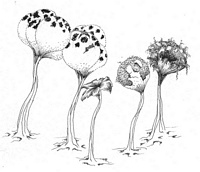|
 Metatrichia floriformis Metatrichia floriformis
SynonymsTrichia botrytis var. lateritia
Trichia lateritia
Trichia floriformis
Metatrichia floriformis
Craterium floriforme
BiostatusPresent in region - Indigenous. Non endemic
Images (click to enlarge)
Caption: Sporangia of Metatrichia floriformis. The one in the middle shows the
petal-like lobes of the peridium. Each intact sporangium is about 2 mm tall.
Owner: S.L. Stephenson |
Article: Stephenson, S.L. (2003). Myxomycetes of New Zealand. Fungi of New Zealand. Ngā Harore o Aotearoa 3: xiv + 238 p. Hong Kong: Fungal Diversity Press.
Description: Fruiting body a stalked (or rarely nearly sessile) sporangium, closely gregarious or fascicled in gregarious clusters, 1.5–2.0 mm tall. Sporotheca turbinate to pyriform, rosey brown or purplish red to almost black, 0.6–1.0 mm in diameter. Stalk irregular, often flattened and repent, rugose, often shiny, clear deep red, translucent by transmitted light, especially above. Hypothallus membranous, contiguous for a group of sporangia, colourless to reddish brown. Peridium consisting of two layers, the outer layer granular, closely adherent to the membranous inner layer but often separating aerolately above and splitting into petal-like lobes below, persistent at the base. Capillitium brick red to brownish orange in mass, consisting of mostly simple, rarely branched elaters 4–6 µm in diameter at the centre and tapering gradually to the long, slender tips, bearing 5 or 6 smooth spirals. Spores bright orange in mass, pale red by transmitted light, densely and minutely spiny, 10–12 µm in diameter. Plasmodium variously reported as white, purple-brown or black.
Habitat: Decaying wood or bark.
Distribution: Predominantly found in coniferous forests in the Northern Hemisphere (Martin & Alexopoulos 1969), but also known from South America (Arambarri 1975) and Australia (Mitchell 1992). First reported (as Trichia botrytis var. lateritia) from New Zealand by Lister & Lister (1905), based on specimens from Dunedin and Stewart Island. Also known from the Kermadec Islands, Auckland (Cheesman & Lister 1915), Taupo, Wellington, Nelson, Buller, Westland, Fiordland, North Canterbury, Mid Canterbury, South Canterbury, Mackenzie, Southland, Auckland Islands, and Campbell Island.
Notes: Metatrichia floriformis is one of the most common myxomycetes in the forests of New Zealand. The brick red to brownish orange spore mass, the tendency of the peridium to form petal-like lobes in mature specimens, and the (usually) relatively long stalk are its major distinguishing features. It is not unusual to find a fruiting in which the individual sporangia have been colonised by the fungus Polycephalomyces tomentosus. The association of certain "myxomyceticolous" fungi with the fruiting bodies of myxomycetes is a common phenomenon, especially in regions (such as tropical rain forests and the west coast of the South Island in New Zealand) that are characterised by continuously high levels of moisture. This group of fungi is described in some detail by Rogerson & Stephenson (1993).
|